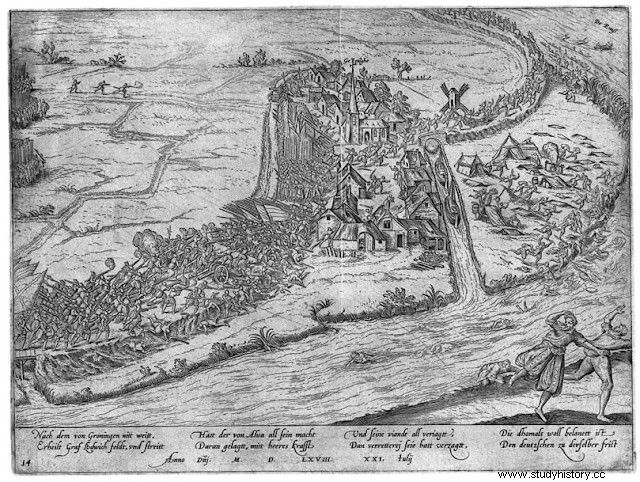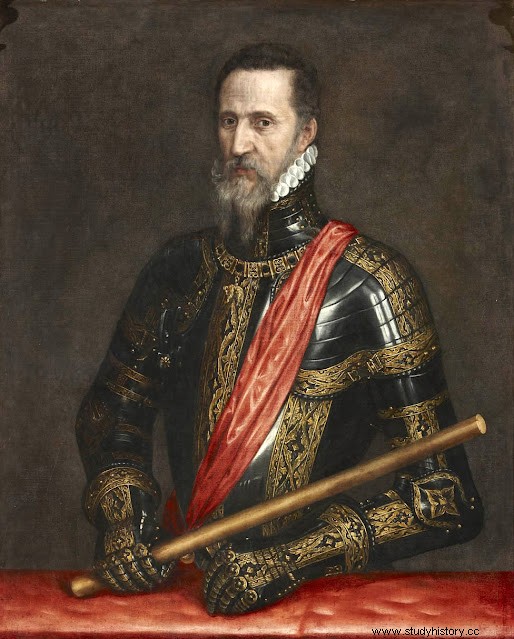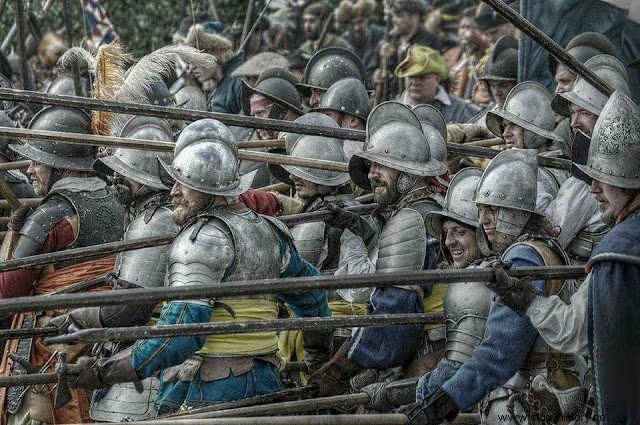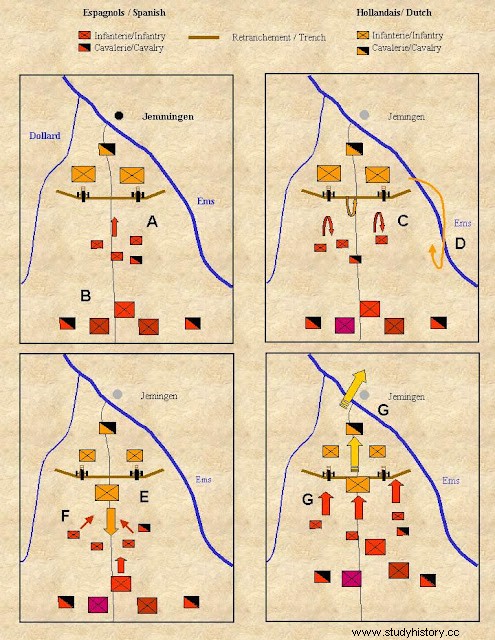"E n Groningen they had news of that defeat due to the number of hats of the German mercenaries that went down the waters of the Ems"
The Grand Duke of Alba, commanding 2,000 soldiers from the Tercios, destroys a Protestant army of 20,000 Dutch soldiers.
 Battle of Jemmingen
Battle of JemmingenThe Battle of Jemmingen, fought on July 21, 1568 as part of the Eighty Years War, was a total victory of the army of the Hispanic Monarchy under the command of Fernando Álvarez de Toledo y Pimentel, III Duke of Alba, in which he completely defeated the mercenary army of the Netherlands commanded by Luis de Nassau .
The Duke had been sent to punish those responsible for the “iconoclastic fury”, which in the summer of 1566 had spread terror by looting churches, destroying images and stealing objects of worship. At that time, Flanders was governed by Felipe II's half-sister, Margarita de Parma, who, after putting down the revolt, was in favor of making concessions to the Calvinists, as the Flemish nobles, who were increasingly annoyed with the Government, had requested, and therefore, closer to the rebels. Felipe II weighed the matter with his advisers and in the end the position of the Duke of Alba prevailed:it was necessary to repress some rebels who, in addition to being rebels, were heretics. The monarch was weighed by the example of France, where permissiveness and tolerance had unleashed a major problem.
 The Grand Duke of Alba
The Grand Duke of AlbaThe Duke of Alba, who arrived in Brussels in August 1567 at Commanding 9,000 men, he soon stirred up the Low Countries. To begin with, he took over the government of the area and ordered the creation of the "Court of Tumults" in order to execute those who had dared to take up arms against his king. His appearance convulsed the rebels.
The Prince of Orange managed to gather an army of German mercenaries under the command of his brother Louis of Nassau. They invaded Groningenel and the Tercio Viejo de Sardinia was surprised in the surroundings of Heilergerlee and half of its men perished in the battle.
After the battle of Heiligerlee, the Dutch mercenary troops commanded by Luis de Nassau tried to take the city of Groningen, but the able general Fernando Álvarez de Toledo y Pimentel, the III Duke of Alba and commander of the Spanish armies, forced them to withdraw through a series of skirmishes without risking a battle, since a defeat would have put all the Netherlands at the mercy of the Dutch rebel forces.
Louis of Nassau made the mistake of shutting himself off on a peninsula between the Ems and Dollar rivers, but at the same time it gave him an advantage, due to the canals and other obstacles . The Dutch army, strong in Jemmingen, opened the locks and flooded the field, hindering the movements of the Spaniards.
Battles of Hispania Official Shop
The Spanish army advanced through the flooded field with water at the height of the knees. Their objective was to reach a bridge over one of the locks.
The Duke of Alba advanced the companies of the Spanish captains Marcos de Toledo, Diego Enríquez and Hernando de Añasco to take it, which they achieved with the attack of the pikemen and the Spanish arquebusiers.
When news reached him about the loss of the bridge, Luis de Nassau observed that it was a very important point for both of them and he sent 4000 men to recover the position, which was barely defended by 500 men . The Spanish detachment resisted the attacks of the Dutch time and time again until the Spanish reinforcements arrived:the Tercio Viejo de Lombardía, commanded by Juan de Londoño, and the Tercio Viejo de Sicilia, led by Field Master Julián Romero.
The Dutch mercenaries decided to flee before the reinforcements and the old two-thirds undertook the pursuit, until they were stopped by artillery fire, already in the Dutch front line. Standing there, the field marshals asked the Duke of Alba for help and reinforcements, as they found themselves greatly outnumbered. The cunning Duke of Alba ignored his request and left them alone in that position, to use them as bait.
 Tercios in combat formation
Tercios in combat formation Luis de Nassau, watching the old two-thirds in an expectant attitude, he decided to attack them with his entire army, made up mostly of Germans. Londoño and Romero waited for him to get closer and then fired. The intense fire of the Spanish arquebusiers stopped the enemy and scared him away. The arquebusiers, seeing that the Dutch were fleeing from the battlefield, pursued them and managed to seize the Dutch artillery and other fortified positions. In this last action, Captain Lope de Figueroa stood out for his courage.
Luis de Nassau's army fled in disarray. The picture was chaotic:the rebels who did not die victims of Spanish steel and lead, drowned in the waters of the rivers that surrounded those lands. It is said that in Groningen they had news of that defeat due to the number of hats of the German mercenaries that went down through the waters of the Ems. The chase lasted all day.
 Development of the battle
Development of the battleAs a consequence of the important victory of the imperial armies, that of Luis de Nassau was totally destroyed and he had to take refuge in Germany, leaving the Duke of Alba free to go against his brother William of Orange, whom he would also defeat a few months later at the Battle of Jodoigne.
| Date | July 21, 1568 | |||
|---|---|---|---|---|
| Place | Jemgum (Lower Saxony,  Germany) Germany) | |||
| Coordinates |  53°15′00″N 7°23′00″ECoordinates: 53°15′00″N 7°23′00″ECoordinates: 53°15′00″N 7°23′00″E (map) 53°15′00″N 7°23′00″E (map) | |||
| Result | Decisive Spanish victory | |||
| Belligerents | ||||
| ||||
| Commanders | ||||
| ||||
| Forces in combat | ||||
| ||||
| Lowers | ||||
| ||||

 Dutch Rebels
Dutch Rebels Hispanic Monarchy
Hispanic Monarchy